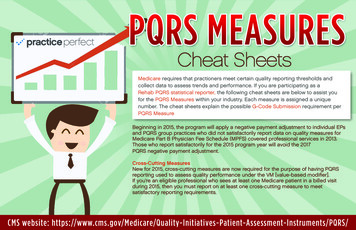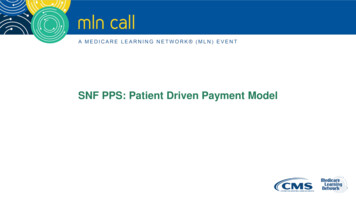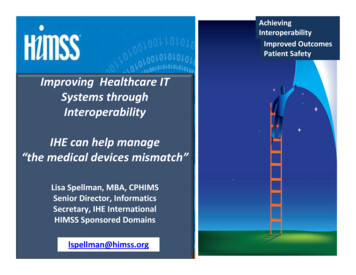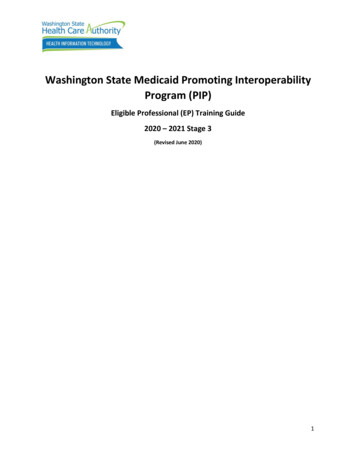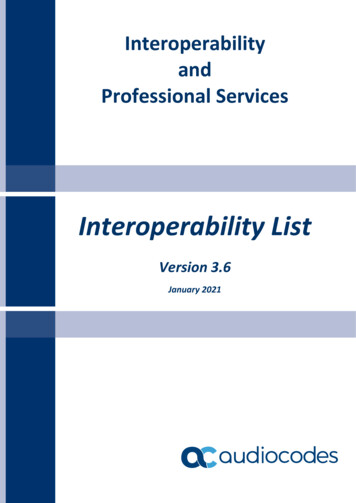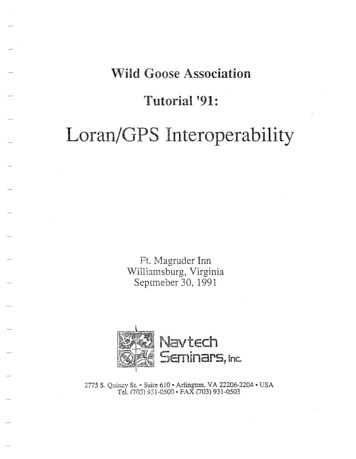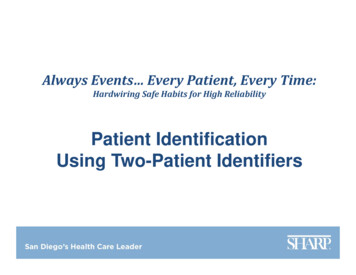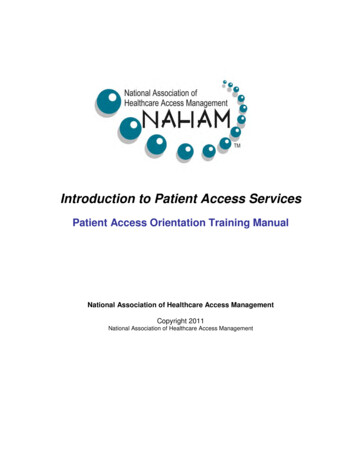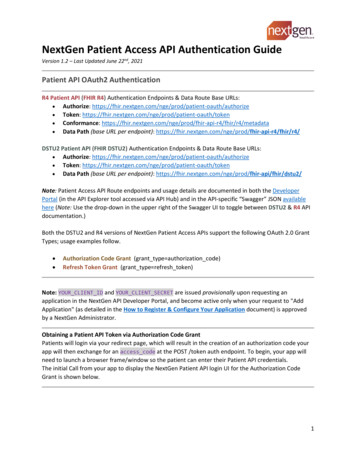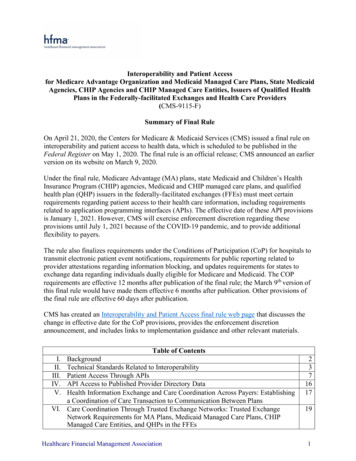
Transcription
Interoperability and Patient Accessfor Medicare Advantage Organization and Medicaid Managed Care Plans, State MedicaidAgencies, CHIP Agencies and CHIP Managed Care Entities, Issuers of Qualified HealthPlans in the Federally-facilitated Exchanges and Health Care Providers(CMS-9115-F)Summary of Final RuleOn April 21, 2020, the Centers for Medicare & Medicaid Services (CMS) issued a final rule oninteroperability and patient access to health data, which is scheduled to be published in theFederal Register on May 1, 2020. The final rule is an official release; CMS announced an earlierversion on its website on March 9, 2020.Under the final rule, Medicare Advantage (MA) plans, state Medicaid and Children’s HealthInsurance Program (CHIP) agencies, Medicaid and CHIP managed care plans, and qualifiedhealth plan (QHP) issuers in the federally-facilitated exchanges (FFEs) must meet certainrequirements regarding patient access to their health care information, including requirementsrelated to application programming interfaces (APIs). The effective date of these API provisionsis January 1, 2021. However, CMS will exercise enforcement discretion regarding theseprovisions until July 1, 2021 because of the COVID-19 pandemic, and to provide additionalflexibility to payers.The rule also finalizes requirements under the Conditions of Participation (CoP) for hospitals totransmit electronic patient event notifications, requirements for public reporting related toprovider attestations regarding information blocking, and updates requirements for states toexchange data regarding individuals dually eligible for Medicare and Medicaid. The COPrequirements are effective 12 months after publication of the final rule; the March 9th version ofthis final rule would have made them effective 6 months after publication. Other provisions ofthe final rule are effective 60 days after publication.CMS has created an Interoperability and Patient Access final rule web page that discusses thechange in effective date for the CoP provisions, provides the enforcement discretionannouncement, and includes links to implementation guidance and other relevant materials.I.II.III.IV.V.Table of ContentsBackgroundTechnical Standards Related to InteroperabilityPatient Access Through APIsAPI Access to Published Provider Directory DataHealth Information Exchange and Care Coordination Across Payers: Establishinga Coordination of Care Transaction to Communication Between PlansVI. Care Coordination Through Trusted Exchange Networks: Trusted ExchangeNetwork Requirements for MA Plans, Medicaid Managed Care Plans, CHIPManaged Care Entities, and QHPs in the FFEsHealthcare Financial Management Association2371617191
VII.VIII.IX.X.XI.Table of ContentsImproving the Medicare-Medicaid Dually Eligible Experience by Increasing theFrequency of Federal-State Data ExchangesInformation Blocking Background and Public ReportingProvider Digital Contact InformationRevisions to the Conditions of Participation for Hospitals and CAHsRegulatory Impact Analysis1920222326Simultaneous with the issuance of this final rule, the Office of the National Coordinator forHealth Information Technology (ONC) of the Department of Health and Human Services (HHS)issued a related final rule “21st Century Cures Act: Interoperability, Information Blocking, andthe ONC Health IT Certification Program,” which implements certain provisions of the 21stCentury Cures Act (P.L. 114-255), including those involving information blocking, conditionsand maintenance of certification requirements for health information technology (health IT)developers, and modifications to ONC’s 2015 Edition health IT certification criteria. It is alsoscheduled to be published on May 1, 2020.I. BackgroundIn this final rule CMS aims to use its authority to advance the electronic exchange of patienthealth information and improve patient access to their health information. The agency says thekey “touch points” of the rule are: Enabling patients to access health information electronically without special effort throughAPIs. Ensuring that providers have access to information on patients regardless of where theypreviously received care; preventing providers from inappropriately restricting the flow ofinformation to other providers and payers; and reducing burden on providers. Ensuring that payers make enrollee electronic health information available through anAPI. Making it easy for patients and providers to identify providers within a plan’s network.The history of HHS efforts to promote interoperability of electronic health records was reviewedin the proposed rule (84 FR 7612-14). This includes provisions of the 2017 Executive Order13813 to Promote Healthcare Choice and Competition Across the United States, themyHealthEData initiative, and a variety of other activities dating back to the 2004 creation of theONC and the 2009 enactment of the Health Information Technology for Economic and ClinicalHealth (HITECH) Act (P.L. 115-5).Challenges and barriers to interoperability are described, which CMS identified throughstakeholder meetings, comments received on RFIs, through letters and during rulemaking. Themajor barriers named are the lack of a unique patient identifier (the subject of an RFI in theproposed rule); the lack of standardization; information blocking; the lack of adoption ofcertified health information technology among post-acute care providers; and privacy concerns.Healthcare Financial Management Association2
II. Technical Standards Related to InteroperabilityIn this section of the rule CMS describes the framework and general approach it has taken infinalizing specific standards for MA organizations, state Medicaid and CHIP agencies, Medicaidand CHIP managed care organizations, and QHP issuers in the FFEs (referred to collectively inthe preamble to the rule as “payers”) that are set forth in section III.C, summarized below.A. Technical Approach and StandardsFor purposes of this final rule, CMS uses the definition of interoperability that appears in section3000 of the Public Health Service Act (as amended by the 21st Century Cures Act):The term "interoperability", with respect to health information technology, means suchhealth information technology that(A) enables the secure exchange of electronic health information with, and use ofelectronic health information from, other health information technology without specialeffort on the part of the user;(B) allows for complete access, exchange, and use of all electronically accessible healthinformation for authorized use under applicable State or Federal law; and(C) does not constitute information blocking as defined in section 300jj–52(a) of [thePublic Health Service (PHS) Act].CMS states that a core policy principal in the final rule is that “.every American should be able,without special effort or advanced technical skills, to see, obtain, and use all electronicallyavailable information that is relevant to their health, care, and choices – of plans, providers, andspecial treatment options.” The types of information envisioned are both specifically about theindividual (which requires protection of the individual’s privacy) and information of generalinterest that should be widely available (e.g., a health plan’s provider network, formulary, andcoverage policies).An API is described as a set of commands, functions, protocols, or tools published by a softwaredeveloper that enables other developers to create programs (applications or “apps”) that interactwith the software without needing to know its internal workings and that maintain consumer dataprivacy standards.CMS is using its authority in Medicare, Medicaid, CHIP and over QHPs in FFEs to require thatplans in these programs adopt and implement openly published, secure, standards-based APIs.These have been generally referred to as “open APIs” in the proposed rule and elsewhere, butCMS is concerned that the word open may suggest “not secure.” Therefore, the term “standardsbased API” is used in this final rule instead.CMS intends that enrollees in these plans will be able to use an application (or “app”) of theirchoice to access their own electronic health information and other information to manage theirhealth. It believes that under the final rule claims and encounter information will become easilyHealthcare Financial Management Association3
accessible for the vast majority of patients enrolled with payers regulated by CMS, and hopesthat state-based exchanges may adopt similar standards for participating QHPs and that otherpayers will voluntarily offer enrollees the type of data access provided under this final rule.As described further below, CMS is relying on the API technical standard adopted in theseparately published ONC final rule on interoperability. However, CMS emphasizes that payersare not required to use ONC-certified Health IT Modules to make administrative data such asclaims history or provider directory information available to enrollees.Three key attributes of standards-based APIs are identified by CMS: standardized APItechnologies, technically transparent APIs, and APIs implemented in a pro-competitive manner.These features were discussed in detail in the proposed rule, and CMS says no comments werereceived on that general discussion.B. Privacy and Security Concerns in the Context of APIsCMS acknowledges stakeholder concerns about the privacy and security risks created by an APIconnecting to third-party applications. This was discussed in the proposed rule, where CMSnoted that under the Health Insurance Portability and Accountability Act (HIPAA), coveredentities and business associates responsible for protected health information (PHI) might believethey are responsible for determining whether an application to which an individual directs theirPHI applies appropriate safeguards for the information it receives. At that time CMS reiteratedand cited Office of Civil Rights (OCR) guidance1 under which covered entities are notresponsible for the security of PHI under HIPAA rules once PHI has been received by a thirdparty application chosen by an individual. Further, with respect to stakeholder concerns thatunscrupulous actors could use direct-to-consumer applications to profit from obtaining and usingor disclosing PHI without the individual’s authorization, CMS noted that the Federal TradeCommission has the authority to investigate and take action against unfair trade practices. Inorder to ensure that enrollees are better informed about how to protect their PHI, in section IIICMS finalizes requirements on payers to assist in this regard.HIPAA-covered entities and business associates are encouraged to review their responsibilitiesunder HIPAA considering the recent decision in Ciox Health, LLC v. Azar, et al., (No. 18-cv0040; D.D.C. January 23, 2020).2 This ruling vacates a portion of the HIPAA Privacy Rule thatprovides an individual the right to direct a covered entity to send protected health informationthat is not in an EHR to a third party identified by the individual. CMS notes that this decisiondoes not affect its programmatic authorities to finalize the standards-based API requirements forthe programs specified in this rule, nor does it alter the rights of an individual under HIPAA torequest and obtain a copy of their records. CMS believes that because the goal of the standards-Readers are referred to OCR guidance available at this link: /guidance/access/index.html2Court documents on this case available at https://ecf.dcd.uscourts.gov/cgi-bin/show public doc?2018cv0040-51and althcare Financial Management Association4
based API requirement is to give patients access to their own information for their own personaluse, the final rule policies are consistent with the spirit of access rights under HIPAA.CMS responds to many comments regarding privacy and security of APIs. It emphasizes thatonce data are transmitted and no longer under the control of the HIPAA-covered entity orbusiness associate, those entities no longer have any obligation under HIPAA for the privacy andsecurity of the PHI, and these data are no longer subject to HIPAA. As discussed below, the onlycircumstance under which a payer can deny access to an app is if the payer (or businessassociate’s) own systems would be endangered by engagement with the app through an API.Under HIPAA, payers are free to advise patients on the potential risks involved with transferringdata to an app that is not covered by HIPAA, but the payer may not substitute its own judgmentfor the patient’s and must share the data if the patient still wants the transfer after being providedthe information. As noted earlier, CMS finalizes requirements for payers to provide educationalinformation to enrollees on protecting the security of their PHI (summarized in section IIIbelow).As discussed in section III below, under this rule payers are required to education patients onhow to choose a third-party app that best mitigates risks associated with secondary data uses.CMS will provide payers with suggested content for this purpose and a framework for requestingthat third-party apps attest to addressing certain issues in their privacy policy, includinginforming users about secondary data use.Some commenters suggested creating a safe harbor for HIPAA-covered entities whentransferring data to an app. CMS says that it does not have authority to do this and it also doesnot believe this is necessary because covered entities and business associates are not responsiblefor the data once it has been transferred. Comments on overlapping federal and state privacylaws and the need for new consumer privacy protections are deemed beyond the scope of thisregulation.Agreeing with commenters that app developers are not subject to regulations protecting theprivacy and security of electronic health information, CMS notes that although it cannot regulatethird-party apps directly, it is sharing information with app developers on best practices andlessons learned from its experience with Blue Button 2.0. (See the web page link on page 1 ofthis summary.) In addition, the ONC final rule includes technical requirements for APIs thatenable and support persistent user authentication and app authorization, although CMSrecognizes that this does not address concerns about data security with the third party.In the proposed rule, CMS requested comments on whether existing privacy and securitystandards, including those under HIPAA, are sufficient for its API policies or whether additionalprivacy and security standards should be required. In responding to comments it receivedregarding privacy and security around consent, authentication, and verification, CMS notes thatthe API security protocols it is adopting by reference to the newly finalized ONC API standard(45 CFR 170.215) include not only HL7 FHIR Release 4.0.1 but complementary security andapp registration protocols, specifically the SMART Application Launch Implementation Guide1.0.0, which is a profile of the OAuth 2.9 specification and the OpenID Connect Core 1.0Healthcare Financial Management Association5
standard, incorporating errata set 1.3 CMS says that this approach supports multifactorauthentication, which it sees as a best practice for privacy and security in health care settings. Inaddition, this technology can be used to support parsing or segmenting data using the API, whichHHS is exploring for the future.Differences in terminology used in this final rule, the ONC final rule, and the OCR guidance arediscussed in response to comments. CMS notes that OCR guidance refers to an “electronic healthrecord system developer” and an “app developer” while this final rule refers to any “developer ofa third-party app,” which may include an electronic record system developer. CMS notes that itdoes not use ONC program-specific terms in this rule.C. Specific Technical Approach and StandardsThe specific standards finalized for APIs and summarized in section III.C include content andvocabulary standards for representing electronic health information and technical standards bywhich an API must make electronic health information available. The standards align with theinteroperability standards in the ONC final rule, and CMS notes that commenters agreed withthis approach. The standards were detailed in the proposed rule and key elements are highlightedhere. CMS finalizes its proposal to adopt by cross reference the API technical standardincluded in the ONC final rule (45 CFR 170.215). By doing this, it is effectivelyrequiring the use of the foundational Health Level 7 (HL7 ) Fast HealthcareInteroperability Resources (FHIR) Release 4.0.1 standard with associated implementationspecifications and OpenID Connect Core 1.0, incorporating errata set 1. The specific content and vocabulary standards finalized in this rule are:o United States Core Data for Interoperability (USCDI) Version 14, as adopted in theONC final rule (45 CFR 170.213) ando HIPAA Administrative Simplification transaction standards (45 CFR part 162) or theMedicare Part D e-prescribing transaction standards (42 CFR 423.160) whererequired by law or where applicable to the data type or elementPayers may use updated versions of required standards if the updated version is required byanother applicable law or is not prohibited under another law, provided that (1) for standardsother than the USCDI, the Secretary has not prohibited use of the updated version, (2) for theUSCDI and API standards, the ONC has approved updates to its standards for use in the ONCHealth IT Certification program, and (3) use of the updated version does not disrupt an end-usersability to access data through the API.Additional information on the SMART App Launch Framework is available at ealthit.gov/USCDI3Healthcare Financial Management Association6
III. Patient Access Through APIsA. Background on Medicare Blue ButtonCMS describes the Medicare Blue Button 2.0 initiative, under which beneficiaries can accessclaims and encounter data for Medicare parts A, B and D and share the information with apps,services, and research programs through an API. CMS believes beneficiaries benefit from havingsecure access to claims data in a standardized computable format.B. Expanding the Availability of Health InformationThe benefits of information access are discussed. CMS views the combination of claims andencounter data used in conjunction with EHR data as providing a broader picture of anindividual’s interactions with the health care system than EHR data alone. It says these data canempower individuals to make informed health care decisions, and individuals can facilitatecommunication with multiple health care providers by allowing them to access the sameinformation through a standards-based API. CMS notes that use of a standards-based API willprovide an additional method for individuals to exercise the HIPAA right of access to PHI,although it may be that not all EHR information subject to the HIPAA right of access would betransferable through the API. For example, an X-ray image that is not captured in the USCDIwould have to be shared in a manner other than the API.C. Standards-based API for MA, Medicaid, CHIP, and QHP Issuers in FFEsThe specific requirements for payers to implement, test and maintain the standards-based APIthat permits third-party applications to retrieve data from the payer at the direction of an enrollee(“Patient Access API”) are detailed in this section of the final rule. “Nearly identical” regulatorylanguage is adopted for each payer; the sections of 42 CFR that are affected are those for MAorganizations (422.119); state Medicaid fee-for-service programs (431.60); Medicaid managedcare plans (438.242(b)); CHIP fee-for-service p
API. Making it easy for patients and providers to identify providers within a plan’s network. The history of HHS efforts to promote interoperability of electronic health records was reviewed in the proposed rule (84 FR 7612-14). This includes provisions of the 2017 Executive Order
